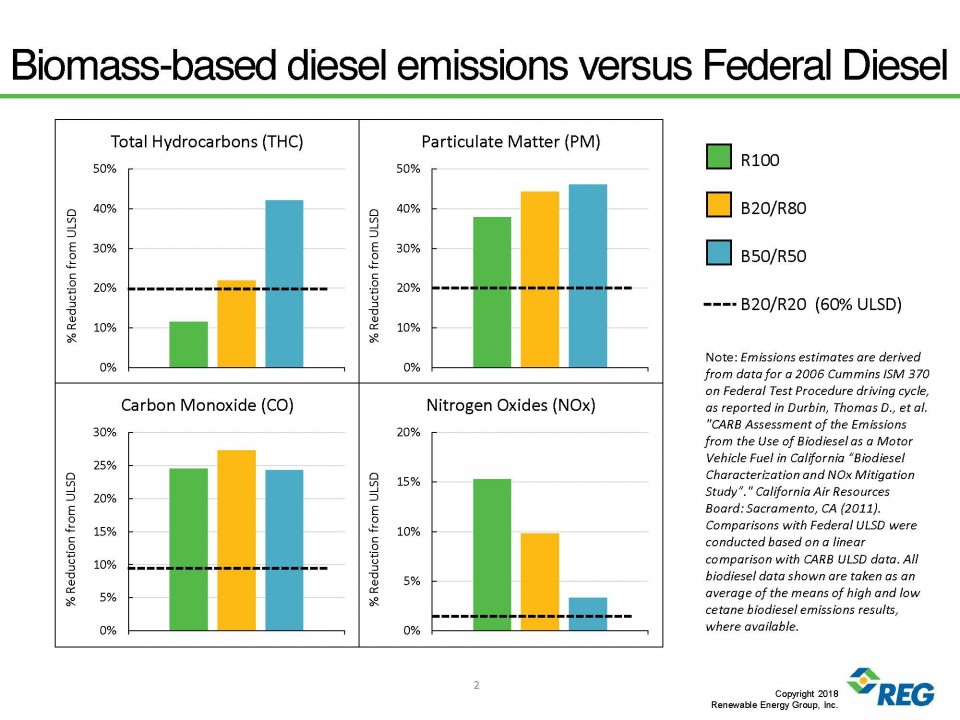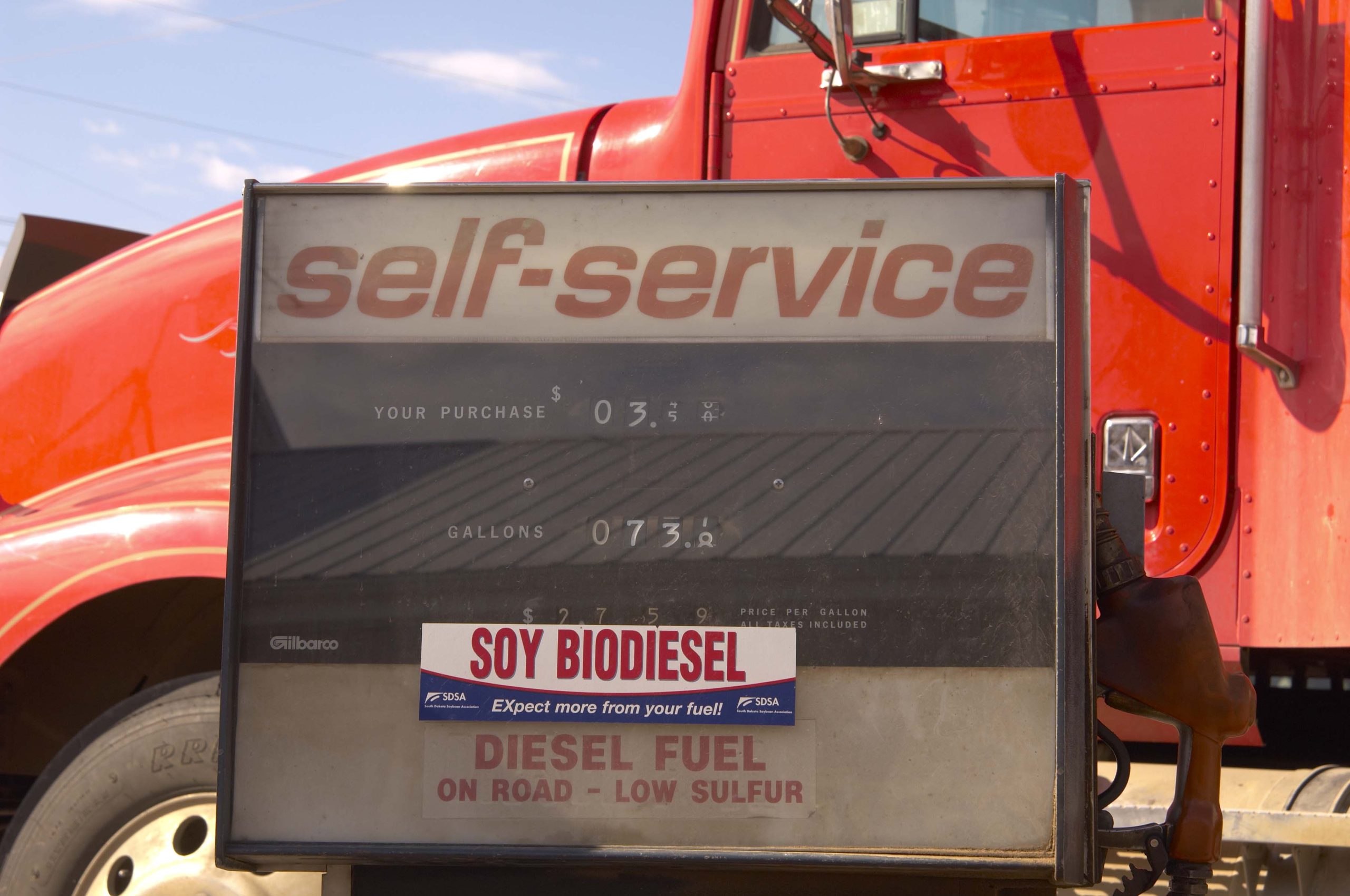Alternative fuels and technologies can include transportation fuels such as renewable natural gas, propane autogas, biodiesel, ethanol, electricity, and more.
There are currently two sustainable diesel fuel replacements meant to displace the use of traditional petroleum diesel in the marine and on-road and off-road markets in the United States – renewable diesel and biodiesel. While similar in chemical makeup and purpose, these are distinct fuels with some important differences between them. Understanding these differences is the first step to making the most informed decision when considering a diesel fuel alternative.
What is Renewable Diesel?
Renewable diesel is chemically identical to petroleum-derived diesel, but it comes from feedstocks like soybean oil, distillers’ corn oil, recycled animal fats, and waste greases. Because it’s so similar to petroleum diesel fuel, renewable diesel meets the same ASTM D975 specification and can generally run in any diesel engine without blending requirements or engine modifications. On top of that, renewable diesel is extremely high in cetane, which helps diesel engines run more efficiently and produce fewer emissions.
There are currently eleven refineries producing renewable diesel in the U.S., with 2.6 billion gallons of production capacity. The largest domestic renewable diesel producer is Diamond Green Diesel, a joint venture between Darling Ingredients and Valero, which has the capacity to produce 1.2 billion gallons of high-quality renewable diesel fuel at its two refineries in Port Arthur, Texas, and Lake Charles, Louisiana. Other large capacity producers in the U.S. include Chevron Renewable Energy Group and Marathon Petroleum Corp.
Most renewable diesel is produced through a process called hydrotreating, which is also used to produce petroleum-based diesel fuel. In the case of renewable diesel, however, the process uses hydrogen to remove water and oxygen particles from the renewable oil or fat being processed, rather than crude oil. After the hydrotreatment process is complete, the resulting fuel is typically isomerized to further remove impurities, which allows refiners to produce desirable cold-flow properties.
While this process has become standard for most of the domestic producers in the U.S., it is not always the case. There are companies that co-process crude oil with renewable feedstocks and market the finished fuel as renewable diesel. Others in the industry are also working to produce diesel fuel by processing waste sources, like recycle plastics, into fuel. While both co-processed fuels and fuel made from waste products can reduce lifecycle carbon emissions, they typically do not qualify as an advanced biofuel under the Renewable Fuel Standard because they aren’t made from renewable resources and/or they don’t meet the 50% minimum carbon reduction requirement.
What is Biodiesel?
Biodiesel is an advanced biofuel produced through a process known as transesterification, which produces a fuel that is chemically similar to petroleum diesel and renewable diesel that meets the ASTM D6751 standard. Like renewable diesel, biodiesel is produced from non-fossil-fuel feedstocks like soybean oil and used cooking oil. Unlike renewable diesel, biodiesel is non-toxic and biodegradable, meaning that it poses virtually no threat to the environment or public health if spilled or otherwise released.
Biodiesel was also the first and only advanced biofuel to meet the Tier I and Tier II health effects testing requirements under the Clean Air Act. The second part of the study found that even at an intermediate level of exposure to biodiesel exhaust – a far higher than any human would ever be exposed – biodiesel posed no threat to human health. The first part of the study also showed significant reductions in harmful pollutants like particulate matter and carbon monoxide.
Biodiesel blends up to 100% have been successfully used in older diesel engines without modifications for decades. However, due to the cold flow properties of biodiesel, blends higher than 20% (B20) are not typically used in the winter months. Operators using biodiesel blends higher than B20 in the winter months typically install heated fuel systems or operate the equipment underground where ambient temperatures prevent gelling. A growing number of fleets are also implementing Optimus Technologies’ Vector System, which allows fleets to seamlessly operate on B100 year-round.
Similarities and Differences
Biodiesel and renewable diesel provide a more sustainable alternative to fossil-based diesel fuel that can be used in existing engines with little or no modifications. Utilizing either fuel can bring significant economic, health, and environmental benefits to a fleet.
One of the biggest differences between biodiesel and renewable diesel is that biodiesel comes from a different process: transesterification. Unlike hydrotreating, transesterification doesn’t remove oxygen. The process produces significantly fewer greenhouse gases than conventional diesel, but it does not perform as well in colder climates. However, lower blends such as B5 are considered standard diesel fuel and blends all the way up to B20 can be used relatively easily with proper additives and fuel maintenance practices.
Another difference between biodiesel and renewable diesel is availability and cost. Biodiesel is readily available at an affordable price across much of the United States, while renewable diesel is largely unavailable or affordable outside of the West Coast. The significant cost differential between biodiesel and renewable diesel is only remedied with low-carbon fuel standards like those in California, Oregon, and Washington, which significantly lower the price of renewable diesel. Without such incentives, renewable diesel can be as much as two times the cost of biodiesel. And even with incentives, renewable diesel is often still more expensive than biodiesel, leading fuel marketers to blend up to 20% biodiesel into renewable diesel to lower the cost.
Renewable diesel is also slightly more carbon intensive than biodiesel because it takes an additional pound of feedstock (8.5 lbs vs 7.5 lbs) and more energy to produce each gallon. This is largely the result of the pressure and heat needed to produce the fuel on top of the loss of oxygen that occurs when hydrotreating oils and fats.
Blending biodiesel and renewable diesel together to produce an alternative fuel source can have many benefits itself. Like ultra-low sulfur diesel fuel, renewable diesel is considered a dry fuel that lacks needed lubricity. Biodiesel, on the other hand, has superior lubricity which reduces wear on the engine over time. For this reason, biodiesel is often blended with petroleum diesel and renewable diesel to increase lubricity.
Biodiesel and renewable diesel blends also provide superior emission reductions over each individual fuel. Testing performed by the California Air Resources Board in conjunction with Renewable Energy Group (now Chevron Renewable Energy Group) found that certain blends provided superior reductions when compared to others and each fuel on its own, as shown below.

Sustainable Fuels Come in Many Forms
Businesses and consumers today have more options than they may realize when it comes to sustainable fuels. Learning more about these power sources and their unique advantages will help make the best, most environmentally friendly choices. As the alternative fuel industry grows in the United States, more fleets will have the opportunity to consider which of these fuels could be the right fit for them.
Originally shared by FuelsFix, January 25, 2023. Edited for clarity, June 14, 2023.

